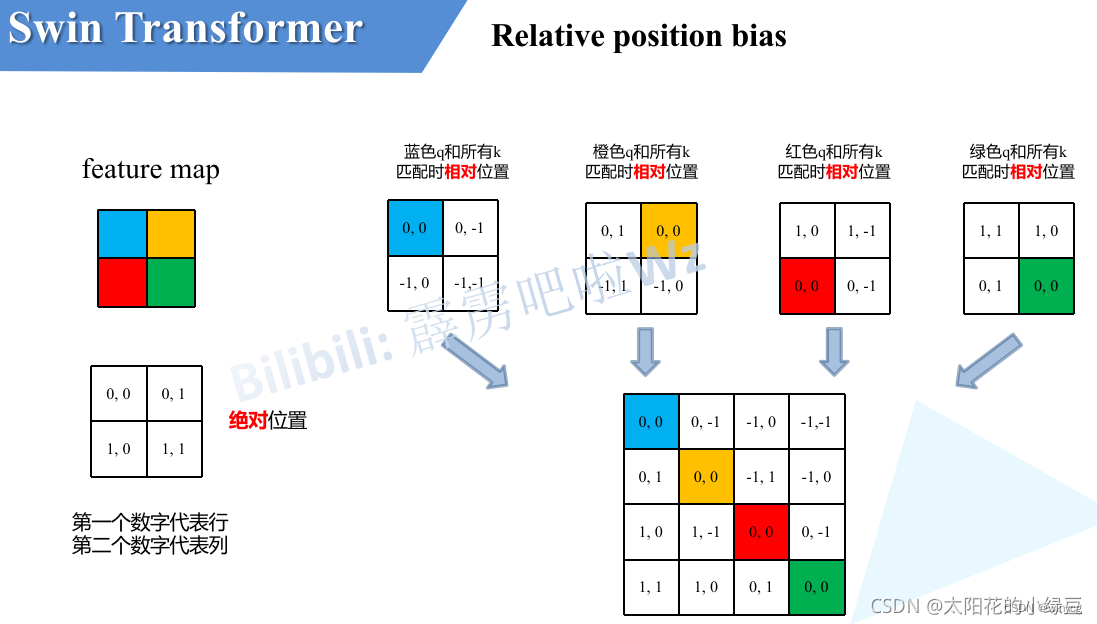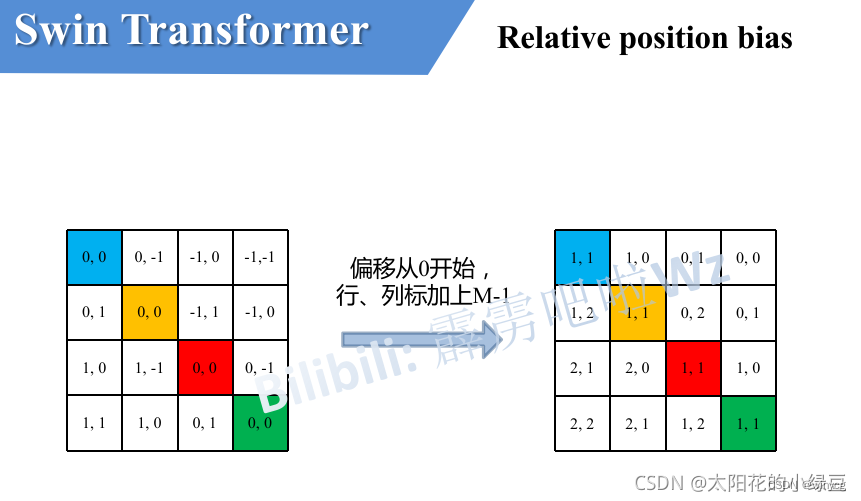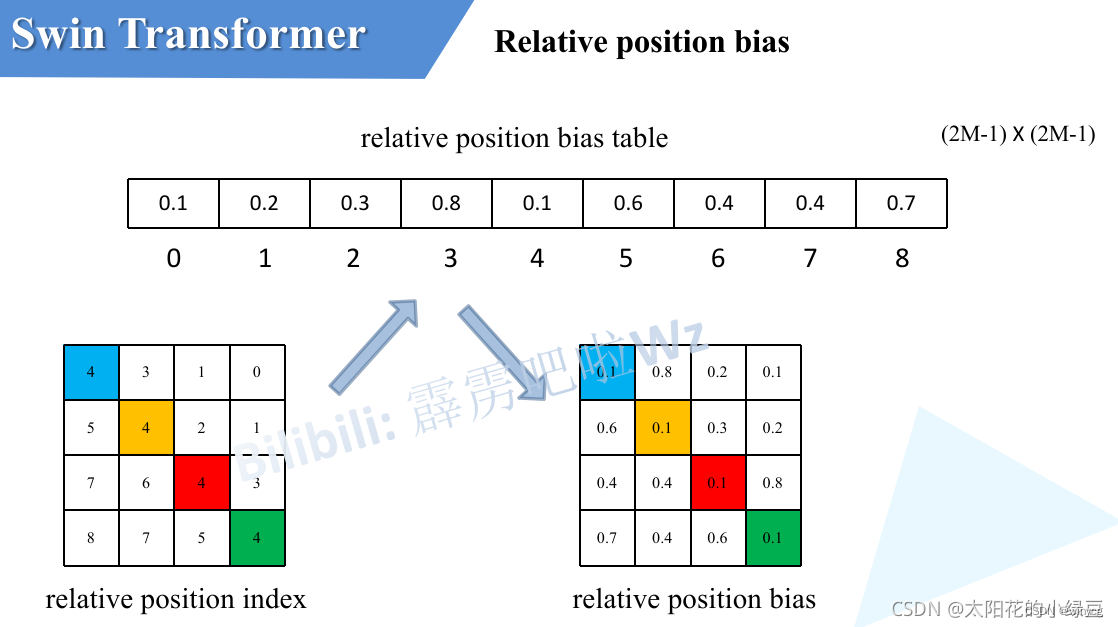绝对位置编码
Vit采用绝对位置编码的形式,也就是使用一个值来表征每个patch的绝对位置,并且基于可学习的方式,一般的定义方式为:
absolute_pos_embed = nn.Parameter(torch.zeros(1, num_patches, embed_dim))
trunc_normal_(absolute_pos_embed, std=.02)
将得到的position encoding直接加到输入的patch embedding就可以了:
x = x + self.absolute_pos_embed
相对位置编码
Swin transformer中采用了相对位置编码的概念,考虑query和key的相对位置进行编码。
具体的详解参考:https://blog.csdn.net/qq_37541097/article/details/121119988
这里的Relative Position Bias是加到self-attention的similarity矩阵计算的时候,而不是patch embedding,且在每层的self-attention计算时候都使用,具体的公式为:
这里是Relative Position Bias。如下图,假设输入的feature map高宽都为2,那么首先我们可以构建出每个像素的绝对位置(左下方的矩阵),对于每个像素的绝对位置是使用行号和列号表示的。比如蓝色的像素对应的是第0行第0列所以绝对位置索引是( 0 , 0 ) (0,0)(0,0),接下来再看看相对位置索引。首先看下蓝色的像素,在蓝色像素使用q与所有像素k进行匹配过程中,是以蓝色像素为参考点。然后用蓝色像素的绝对位置索引与其他位置索引进行相减,就得到其他位置相对蓝色像素的相对位置索引。例如黄色像素的绝对位置索引是( 0 , 1 ) (0,1)(0,1),则它相对蓝色像素的相对位置索引为( 0 , 0 ) − ( 0 , 1 ) = ( 0 , − 1 ) (0, 0) – (0, 1)=(0, -1)(0,0)−(0,1)=(0,−1),这里是严格按照源码中来讲的,请不要杠。那么同理可以得到其他位置相对蓝色像素的相对位置索引矩阵。同样,也能得到相对黄色,红色以及绿色像素的相对位置索引矩阵。接下来将每个相对位置索引矩阵按行展平,并拼接在一起可以得到下面的4×4矩阵 。

>>> coords_h = torch.arange(2)
>>> coords_w = torch.arange(2)
>>> coords = torch.stack(torch.meshgrid([coords_h, coords_w])) # 2, Wh, Ww
>>> coords_flatten = torch.flatten(coords, 1) # 2, Wh*Ww
>>> coords_flatten
tensor([[0, 0, 1, 1],
[0, 1, 0, 1]])
>>> relative_coords = coords_flatten[:, :, None] - coords_flatten[:, None, :] # 2, Wh*Ww, Wh*Ww
>>> relative_coords
tensor([[[ 0, 0, -1, -1],
[ 0, 0, -1, -1],
[ 1, 1, 0, 0],
[ 1, 1, 0, 0]],
[[ 0, -1, 0, -1],
[ 1, 0, 1, 0],
[ 0, -1, 0, -1],
[ 1, 0, 1, 0]]])
>>> relative_coords = relative_coords.permute(1, 2, 0).contiguous() # Wh*Ww, Wh*Ww, 2
请注意,我这里描述的一直是相对位置索引,并不是相对位置偏执参数。因为后面我们会根据相对位置索引去取对应的参数。比如说黄色像素是在蓝色像素的右边,所以相对蓝色像素的相对位置索引为( 0 , − 1 ) (0, -1)(0,−1)。绿色像素是在红色像素的右边,所以相对红色像素的相对位置索引为( 0 , − 1 ) (0, -1)(0,−1)。可以发现这两者的相对位置索引都是( 0 , − 1 ) (0, -1)(0,−1),所以他们使用的相对位置偏执参数都是一样的。但在源码中作者为了方便把二维索引给转成了一维索引。由于索引的值范围为,原始的相对位置索引上加上
,使得索引的值大于等于0,变为
。

>>> M=2
>>> relative_coords[:, :, 0] += M - 1
>>> relative_coords[:, :, 1] += M - 1
>>> relative_coords[:, :, 0] *= 2 * M - 1
>>> relative_position_index = relative_coords.sum(-1)
>>> relative_position_index
tensor([[4, 3, 1, 0],
[5, 4, 2, 1],
[7, 6, 4, 3],
[8, 7, 5, 4]])
之前计算的是相对位置索引,并不是相对位置偏执参数。真正使用到的可训练参数
是保存在relative position bias table表里的,这个表的长度是等于的。那么上述公式中的相对位置偏执参数B是根据上面的相对位置索引表根据查
relative position bias table表得到的,如下图所示。

文章出处登录后可见!
